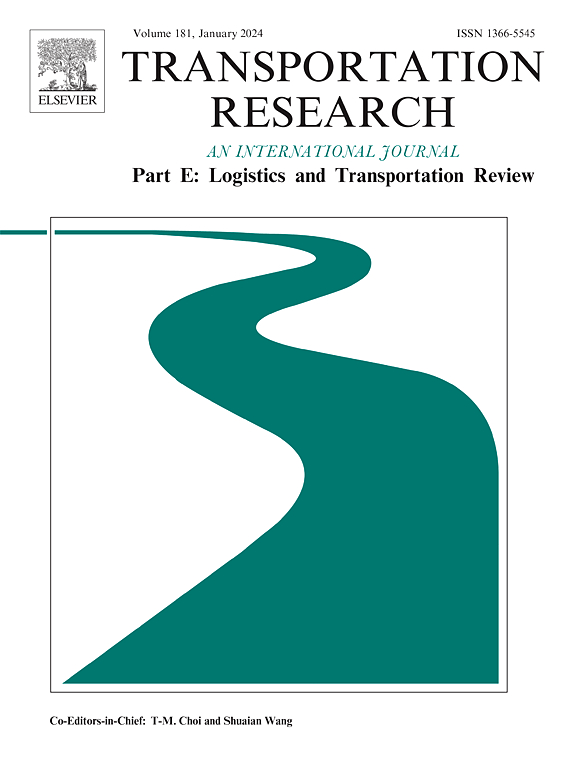Inventory routing problem of automotive parts considering time-varying demands: A machine learning enhanced branch-and-price approach
IF 8.3
1区 工程技术
Q1 ECONOMICS
Transportation Research Part E-Logistics and Transportation Review
Pub Date : 2025-07-21
DOI:10.1016/j.tre.2025.104297
引用次数: 0
Abstract
With the rise of mass customization and smart manufacturing, the automotive industry is rapidly transitioning to improve responsiveness, manage highly diversified customer orders, and reduce inbound logistics costs. To address this challenge, this paper proposes a new variant of the multi-period inventory routing problem, which focuses on coordinating discrete, time-varying demands for auto parts on the assembly line with predetermined packages at suppliers over a finite short-term time horizon (e.g., on an hourly basis). The objective is to minimize the total transportation and inventory cost by making aperiodic decisions on collection quantities and traveling routes simultaneously for an inbound warehouse near the assembly plant. An integer programming (IP) formulation with time-indexed variables is tailored for the problem to analyze the feasibility conditions. Then, a reformulation is designed to make the problem more tractable, based on which a novel machine learning enhanced branch-and-price algorithm (BPL) is proposed, where prediction-based cuts are embedded to accelerate the pricing procedure. Experiments on real-scale instances demonstrate that the algorithm consistently achieves near-optimal solutions, with a gap of 4.42% on average from the best-found lower bound, and reduces computation time by over 90% compared to directly solving the IP model by CPLEX. The proposed learning technique is computationally efficient, capable of shortening the total calculation time by an average of 13%. This work facilitates timely decision-making and offers new insights into multi-period inventory routing for inbound logistics.
考虑时变需求的汽车零部件库存路径问题:一种机器学习增强的分支和价格方法
随着大规模定制和智能制造的兴起,汽车行业正在迅速转型,以提高响应能力,管理高度多样化的客户订单,并降低入站物流成本。为了解决这一挑战,本文提出了多周期库存路径问题的一个新版本,该问题的重点是在有限的短期时间范围内(例如,以小时为单位)协调装配线上具有预定包装的汽车零部件的离散时变需求。目标是通过同时对装配厂附近的入站仓库的收集数量和旅行路线做出不定期的决定,使总运输和库存成本最小化。针对这一问题,提出了带时间索引变量的整数规划(IP)公式,分析了其可行性条件。然后,设计了一个重新表述以使问题更易于处理,并在此基础上提出了一种新的机器学习增强分支和价格算法(BPL),其中嵌入了基于预测的切割以加速定价过程。在实际实例上的实验表明,该算法与最佳下界的平均差距为4.42%,接近最优解,与直接用CPLEX求解IP模型相比,计算时间减少90%以上。所提出的学习技术计算效率高,能够将总计算时间平均缩短13%。这项工作有助于及时决策,并为进站物流的多周期库存路线提供新的见解。
本文章由计算机程序翻译,如有差异,请以英文原文为准。
求助全文
约1分钟内获得全文
求助全文
来源期刊
CiteScore
16.20
自引率
16.00%
发文量
285
审稿时长
62 days
期刊介绍:
Transportation Research Part E: Logistics and Transportation Review is a reputable journal that publishes high-quality articles covering a wide range of topics in the field of logistics and transportation research. The journal welcomes submissions on various subjects, including transport economics, transport infrastructure and investment appraisal, evaluation of public policies related to transportation, empirical and analytical studies of logistics management practices and performance, logistics and operations models, and logistics and supply chain management.
Part E aims to provide informative and well-researched articles that contribute to the understanding and advancement of the field. The content of the journal is complementary to other prestigious journals in transportation research, such as Transportation Research Part A: Policy and Practice, Part B: Methodological, Part C: Emerging Technologies, Part D: Transport and Environment, and Part F: Traffic Psychology and Behaviour. Together, these journals form a comprehensive and cohesive reference for current research in transportation science.

 求助内容:
求助内容: 应助结果提醒方式:
应助结果提醒方式:


